Photo

Okegawa Do Tosei Gusoku. Late Edo Period, 19th century
Thirty-two-plate suji bachi kabuto with itamono komanju jikoro, to the front a gilded wood maedate in the form of a stylised yama kanji. The do of okegawa yokohagi style with the muneita and waki ita in gilded roughened lacquer and with a copy of the maedate painted on the front in red. On the back of the do a sashimono of a large tuft of black hair above red rasha tassels. A simple hanbo mask, chu sode, shino gote, karuta gane haidate and tsutsu suneate. Lacquered black overall and laced in dark blue sugake odoshi. The yodarekake and kusazuri edged with fur.
72 notes
·
View notes
Photo
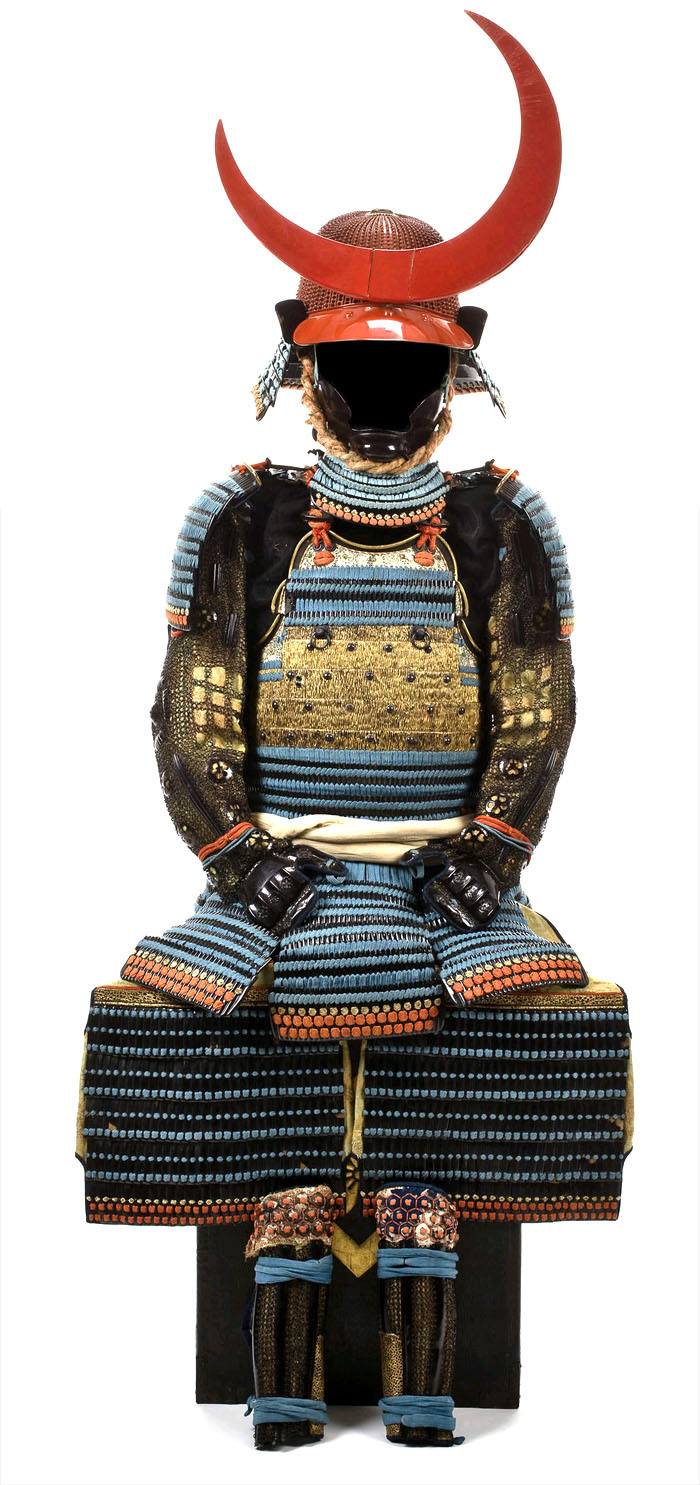
Gold Lacquer Kabuto. 17th-18th century
Sixty-two plate koboshi bachi kabuto lacquered red and surmounted with a three-stage gilt-copper chrysanthemum tehen kanamono, the bowl fitted with a five-lame Hineno-style shikoro ending in small fukigaeshi, lacquered black, The Maedate isa red lacquered-wood crescent moon, black-lacquered iron hanbo fitted with a three-lame yodarekake; the cuirass a nimai yokohagi okegawa do lacquered gold and finished to a rough surface and applied with standing rivets patinated shakudo, the muna ita and the lower section laced kebiki odoshi, fitted with seven sections of five-lame kusazuri; chu sode; kote of mail and plates, some pierced with cherry florets; kawara haidate; shino suneate; black-lacquer armor box with gold-lacquer cherry blossom heraldic crest
118 notes
·
View notes
Photo

Tokugawa Jinbaori (surcoat). 19th century
White cotton coat cut with straight sleeve openings and applied with a black-velvet Tokugawa family crest on two horizontal bands on the reverse, the epaulets black velvet with gold and green stitching and the facing and interior brocade designed with confronted dragons, phoenixes and floral roundels
68 notes
·
View notes
Photo
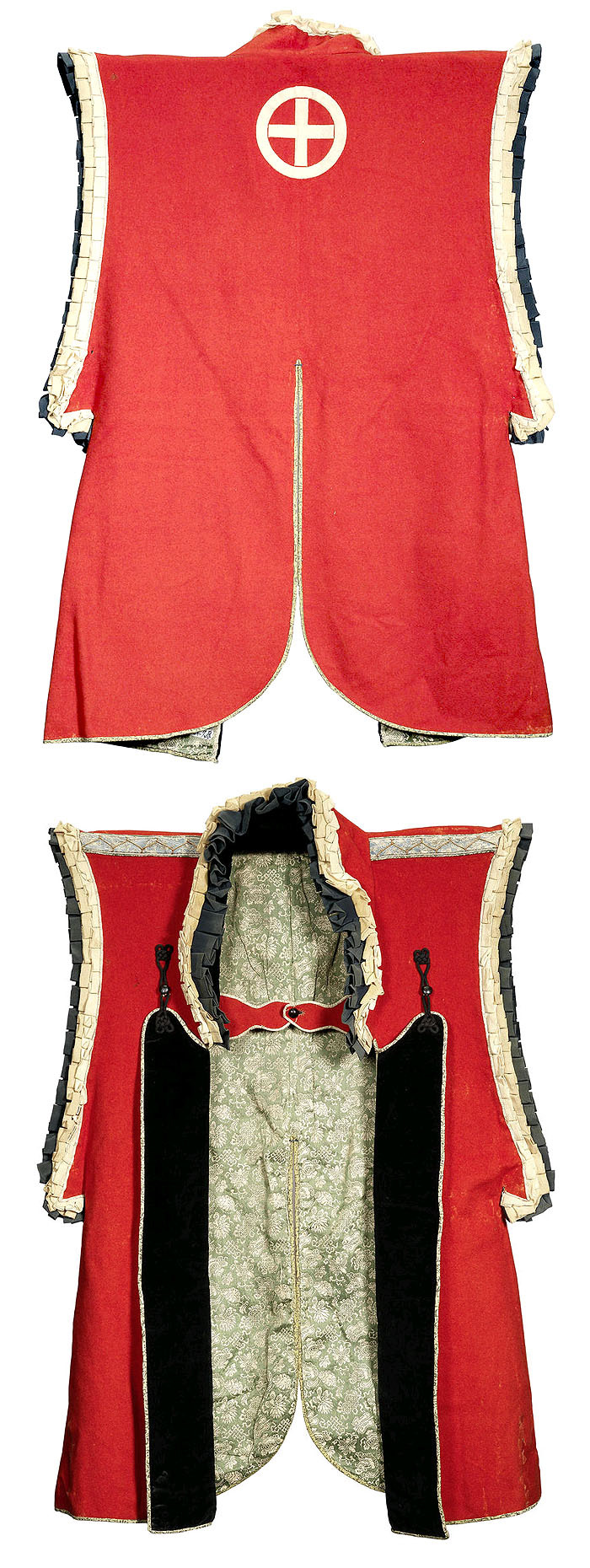
Shimazu family Jinbaori (Surcoat) Edo Period, 19th century
The coat of bright vermilion felt with black turnover and cream silk ruffles at the neck and shoulders, the Maru ni ju-mon ji of the Shimazu family of Sadowara prominently displayed on the back, lined with green silk, bearing a resist design of takaramono and scrolls.
A similar jinbaori is held in Miyakonojo, the Shimazu residence in Miyazaki prefecture.
31 notes
·
View notes
Photo
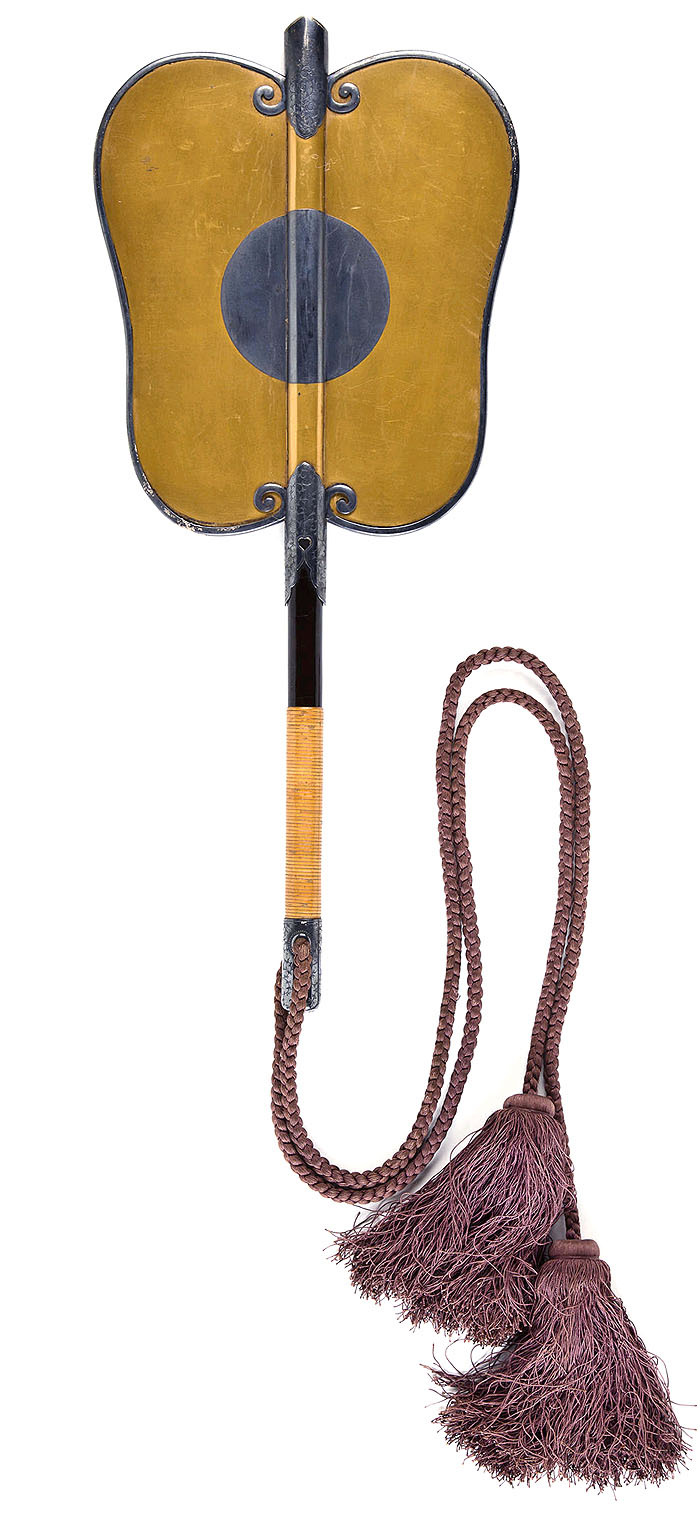
Gold lacquer Gunpai (General's war fan) Edo period, 19th century
Uchiwa shape and decorated in red and silver lacquer against a bright kinji ground with a sun on one side and a full moon on the other, the borders banded with silver edging ending in decorative scroll flourishes and a collar, tip and base all carved with Tokugawa family crests and scrolling vines, handle lacquered black and wrapped with bamboo.
398 notes
·
View notes
Photo

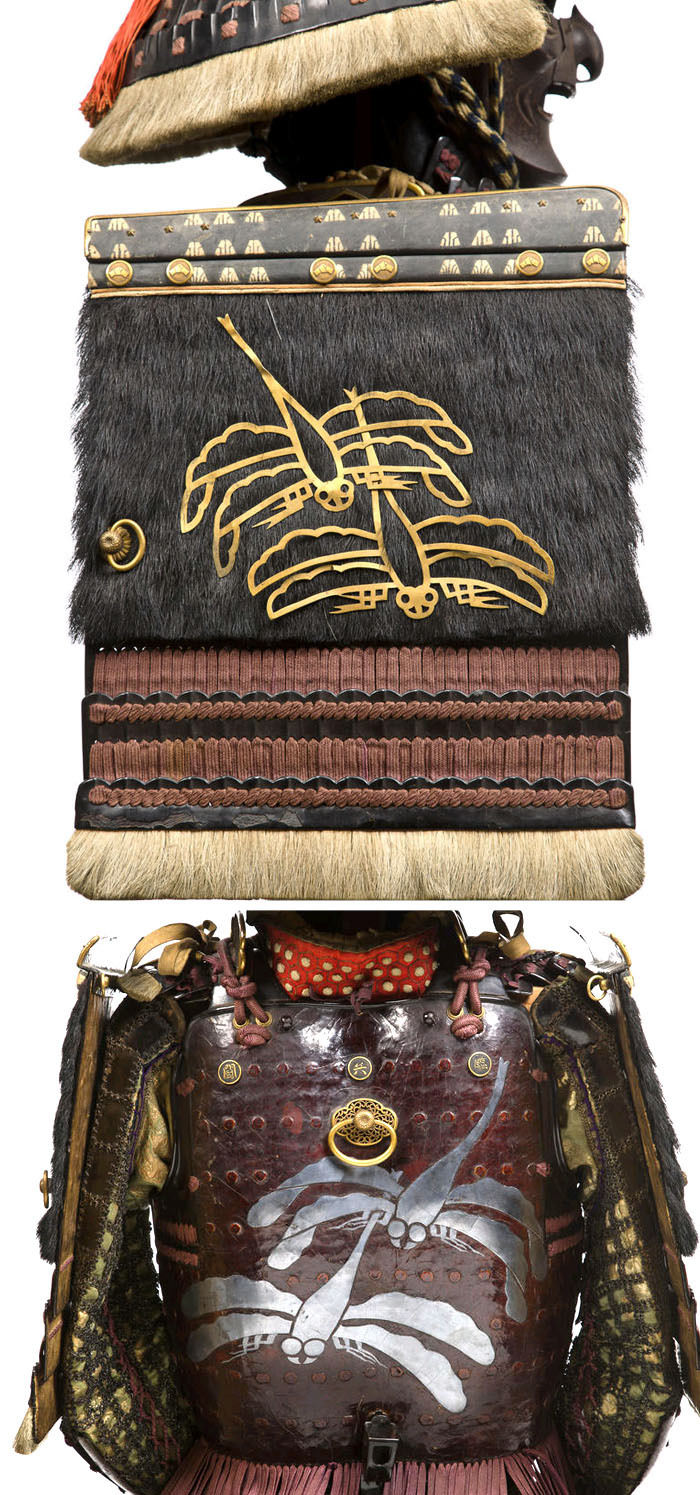
Gusoku with Ni-mai Okegawa Hishinui Do. Momoyama-Edo period, 17th century
Helmet by Iehisa. Armor decorated with a large dragonfly on the front of the do and two dragonflies on the rear in silver lacquer, the rest of the components lacquered black and the lowest lames trimmed in white horse hair, comprising a good sixteen-plate russet-iron hoshi kabuto with large standing rivets, each with "star" bosses and finished with a four-stage shakudo and gilt-copper tehen kanamono, the mabizashi banded with gilt-copper fukurin carved with floral scroll, the helmet fitted with a three-lame lacquered iron shikoro, the lowest lame scalloped on the top edge, the fukigaeshi applied with stenciled doe skin and gilt-copper family crests, interiors lacquered gold, gold-lacquered leather ken and kuwagata maedate, signed on the interior rear Soshu ju Iehisa; okegawa do laced in hishinui style, mounted with shakudo nanako and gold hardware with invocations Hachiman daibosatsu mari shite and Ginpei to, and mounted with a yak-hair pocket on the side of the do, six sections of four-lame kusazuri; the large sode designed with a large iron upper panel applied with black horse hair and decorated with gilt gilt-copper cutouts of a pair of dragonflies, the lower section separated into three lacquered lames.
70 notes
·
View notes
Photo
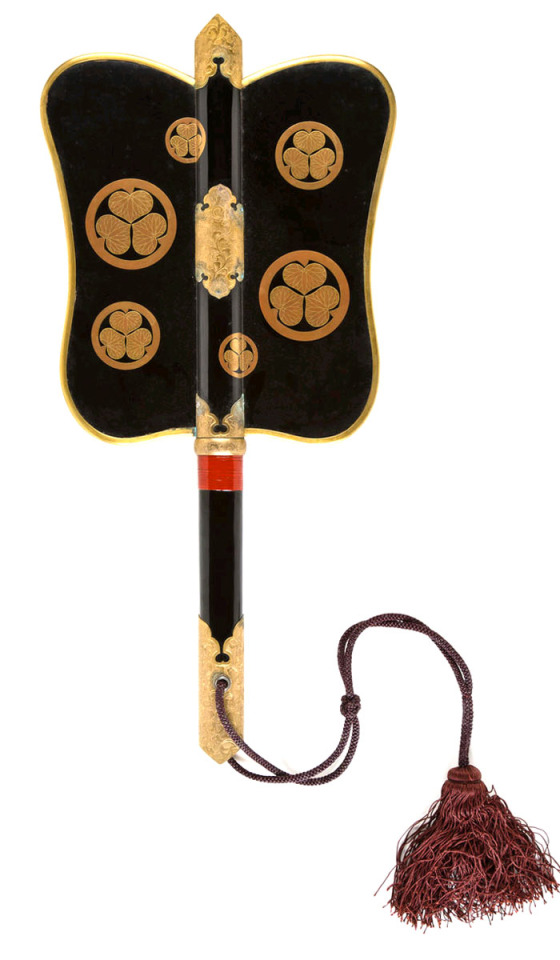

Black and red lacquer Gunpai (General's war fan) Edo period, 19th century
The broad paddle mounted on a short handle and decorated in gold and silver hiramakie with a sun and a crescent moon and the characters Tenka taihei (Universal peace), and the heraldic crests of the Tokugawa family in various sizes against a black-lacquer ground on the reverse, the handle lacquered black and decorated with additional Tokugawa crests, gilt-copper hardware carved with scrolling vines on a nanako ground.
963 notes
·
View notes
Photo


Composite Dangaye Do Tosei Gusoku. Edo Period, 18th century.
Sixty-two-plate ko boshi bachi Momoyama period kabuto with a tosei mabisashi deeply embossed with eyebrows black lacquered, to the front a fore crest in the form of a shogi-no-koma piece from a board game. A hineno shikoro of iron kiritsuke kozane gold lacquered, the lower plate deeply curved over the shoulders. The mask of russet iron in Nara style with hair moustache and chin tuft.
A ni mai dangaye do, the upper section of brown lacquered iyozane the lower of gold lacquered kiritsuke kozane, the kusazuri matching. Kosode of kiritsuke kozane, russet lacquered oda gote, ikada haidate and shino suneate matching. Laced overall in dark blue with the yurugi ito in mauve.
The armour is accompanied by a receipt for an armour by Myochin Munenobu for 35 gold coins.
37 notes
·
View notes
Photo

Composite armour parts, Unsigned. Edo Period
A sixteen plate iron suji-bachi kabuto with four-stage tehan kanemono, down-turned mabizashi, four lame kebiki laced shikiro (lacking fukigayashi), russet lacquered iron do-maru, the upper plates lacquered red, kebiki laced kozane kusazuri, the lower lames trimmed with bear fur, tetsu-gote
28 notes
·
View notes
Photo
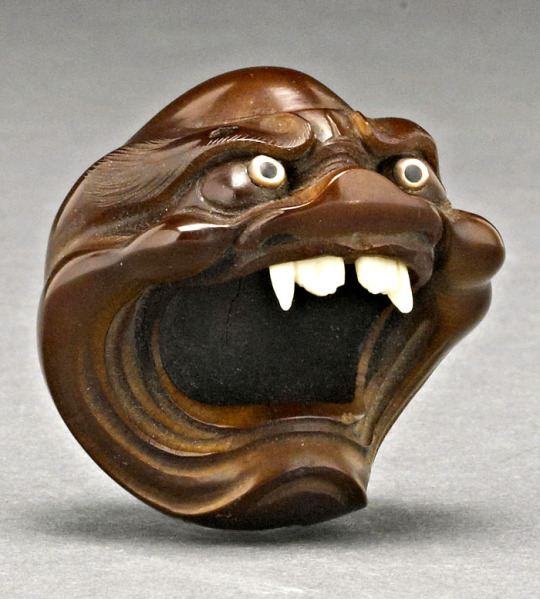
Demonic Head Netsuke in Boxwood. Meiji period
Carved as a demonic head with a wide open mouth inlaid with bone fangs and bushy eyebrows framing large eyes of horn and mother-of-pearl, signed Chokuichi/Naokazu.
1K notes
·
View notes
Photo

Blue Laced Black-lacquered Gusoku. 18th century
Thirty-two plate suji kabuto with a four-stage shakudo and gilt-metal chrysanthemum tehen kanamono and a five-lame shikoro ending in fukigaeshi trimmed in "rope" fukirin and applied with family crests of plum blossoms within circles, the maedate a gold-lacquer rhombus; the menpo applied with a stiff-bristle mustache, red-lacquer upper lip and fitted with a five-lame yodarekake; the yokohagi okegawa hatomune do with standing rivets, fukurin, and applied with an outer pocket on the right side and with seven sections of five-lame kusazuri, the reverse with a bracket for a battle standard; chu sode; oda gote; Etchu haidate; shino suneate.
This armour is Koshu Tokubetsu Kicho Shiryo (Especially valuable material of the top rank) certificate no. 38 issued by the Nihon Bugu Katchu Kenkyu Hozonkai (Society for the Preservation of Japanese Armor), dated 1976
Originally exhibited at "Token to bugu" (Swords and armor) at Daiwa Department Store, Kanazawa City, 1987
27 notes
·
View notes
Photo



Nuinobe Do Tosei Gusoku. Mid to late Edo Period, 18th/19th century
Eight-plate russet-lacquered iron suji bachi kabuto with a tosei mabisashi, a five-lame itamono Hineno jikoro with leaf-shaped fukigaeshi with shakudo fukurin on the front a maedate of gilt kuwagata and a silvered circle, unusual russet-lacquer hambo, ko sode of gold-lacquered kiritsuke kozane laced in bands of blue, mauve and white kebiki odoshi. The nuinobe do black-lacquered with leather covered hinged gyoyo, black-lacquered oda gote, ikada haidate and shino suneate laced overall in a pale gold lacing in sugake style
Nuinobe Dō or Hon-iyozane Dō (large individual scales)
Tosei Dō Gusoku; the so-called "modern armours" made from iron plates (ita-mono)
44 notes
·
View notes
Photo
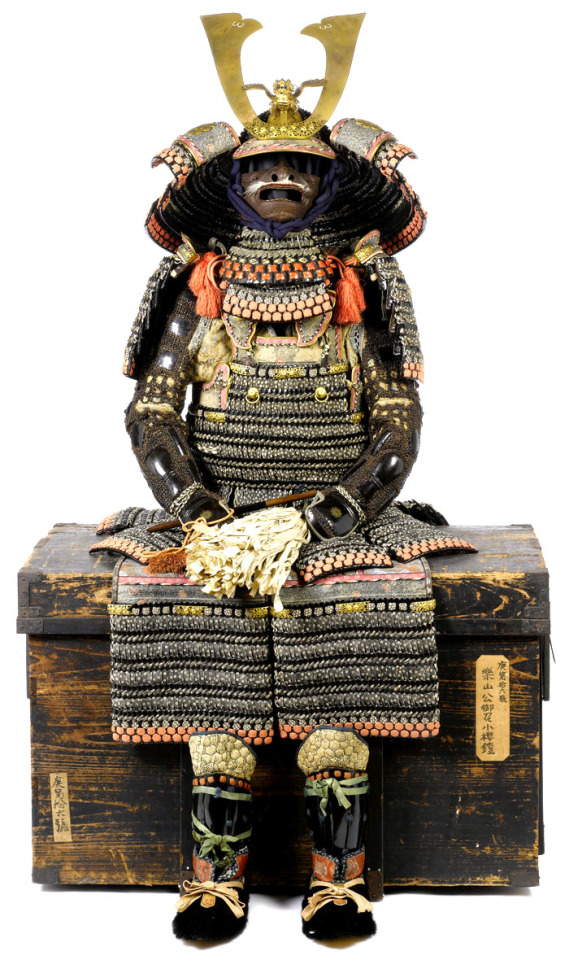



Sakura Gawa Do Maru Gusoku. Late Edo Period, 19th century
Thirty-two-plate russet-lacquered hoshi bachi helmet mounted in nihojiro style with gilt plates overlaid with shinodare, gilt tehen kanamono, on the peak a kuwagata dai and kuwagata and a winged dragon maedate, an o-manju jikoro with large fukigaeshi supporting a large mon in gilt copper, the one-piece leather lining is decorated inside with dragons and clouds. Russet iron menpo with two lame yodarekake with lacquered-leather hishinui and a nodowa. The do in do maru style with gyoyo, chu sode, oda gote, sane haidate, leather tsutsu suneate and a pair of kutsu. Together with a saihai. Constructed with black-lacquered sane laced with reserved dyed sakuragawa in kebiki style and mounted overall in gilt copper.
43 notes
·
View notes
Photo


Iron Nio Somen. By Yoshii, Edo period, 19th century
Forged in one piece in the form of a Nio temple guardian bearing a fierce expression, the surface with traces of black lacquer and pierced with small holes for a mustache and chin tuft (now missing), signed Yoshii; fitted with a three-lame yodarekake and a zukin hood
With a gold-lacquer storage box decorated with birds and peonies in gold hiramakie on a nashiji ground.
28 notes
·
View notes
Photo


Iron Tengu Somen by Myochin Muneharu.Edo period (17th century)
The face plate forged in one piece and the nose and ears separately forged and riveted together, the surface finished in a russet patina and hammered up with prominent wrinkles and eyebrows held in a scowl, with two pegs for cords and one ventilation hole on the chin, the interior lacquered black and red signed Myochin (no) ki Muneharu. Fitted with a four-lame yodarekake lacquered gold and laced in orange
84 notes
·
View notes
Photo

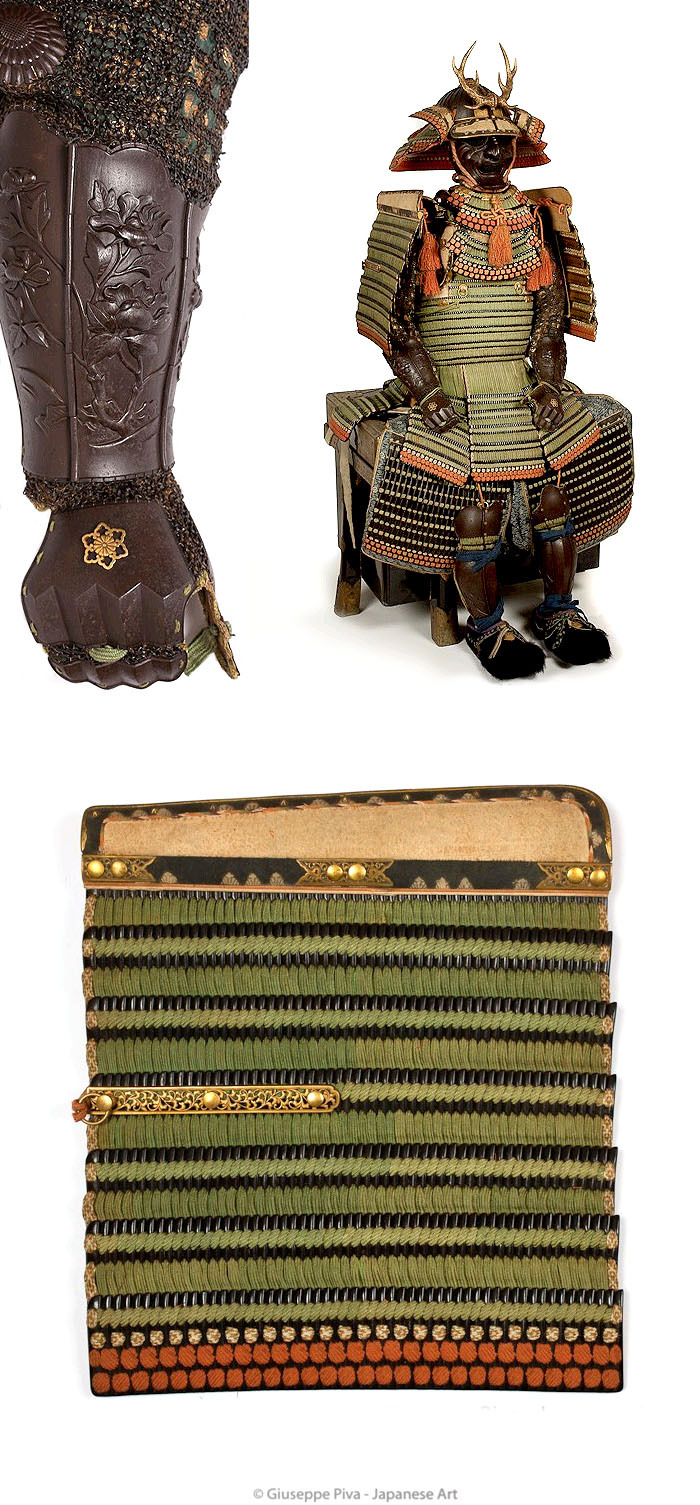

Hon-kozane nimai-dô gusoku. Mid Edo Period (1615-1967)
Tachi-dô style, made in black lacquered hon-kozane (true scale) of iron and leather; the interiors in gold lacquer. The kebiki odoshi in pale green silk. The armour is fitted with a “mutsu karakan ni juni kiku” kamon.
32 plate suji-bachi kabuto. The bowl is mounted in gilt copper and shakudô.
The style of the decoration of this kabuto can be confronted with very similar helmets made by Myochin Munesuke and Muneakira around 1720-30.
The menpô is an exceptional work by Myôchin Muneakira, signed and dated 1732
The forearm of each kote is in sanbon-tsutsu style, made by three hinged plates, with a stunning embossed floral decoration of peonies. The design is in fact on different levels and Muneakira shows a real talent in creating a true three dimensional effect rather than a mere low-relief. The same sharp workmanship is then found on the upper part of the arm, where a shikami (demon) head with a fierce expression is embossed on la large rectangular plate.
I love the Kote design. More information on this beautiful armour can be read at Giuseppe Piva Gallery
67 notes
·
View notes
Photo

Black-lacquer Do-Maru and Myochin-school Kabuto.
Helmet attributed to Muneyasu (Myochin Muneyasu), Muromachi period, 15th-16th century, armor Edo period (18th century)
Constructed of lacquered-leather scales and elegantly laced in white, green and orange in vertical configuration. A sixteen-plate russet-iron suji Kabuto constructed of broad plates worked on the surface to a rough texture, the flanges fitted with gilt-copper fukurin and surmounted by a four-stage gilt-copper tehen kanamono, the mabisashi applied with stenciled doe skin, trimmed in gilt-metal fukurin and fitted with gilt-metal kuwagata dai pierce carved with chrysanthemums and floral scroll and supporting a gilt-metal kuwagata and a large disc maedate, the bowl fitted with a wide three-lame omanju jikoro and a full fukigaeshi applied with stenciled doe skin and gilt-metal family crests; the do-maru lacquered with a "stone finish" mounted with gilt-copper hardware, some of it carved with paulownia crests on a nanako ground, the munaita applied with stenciled doe skin decorated with the Sanskrit character for Fudo Myo-o, the wakiita applied with gilt leather, seven sections of four-lame kusazari
64 notes
·
View notes